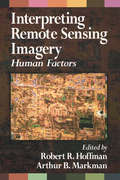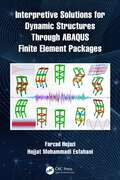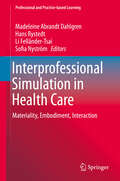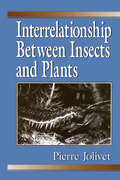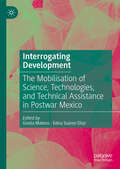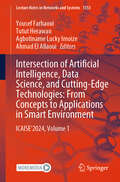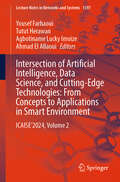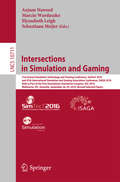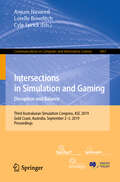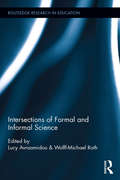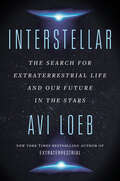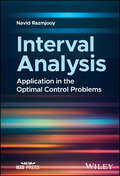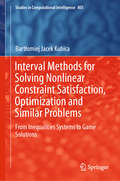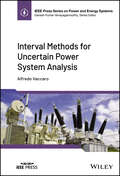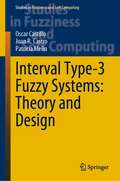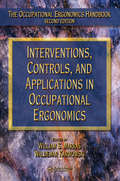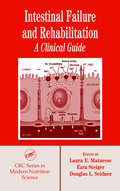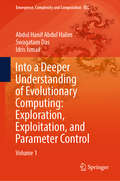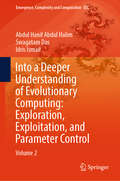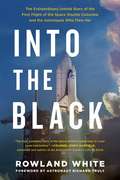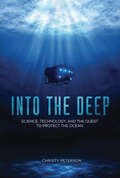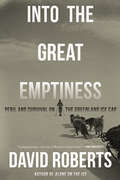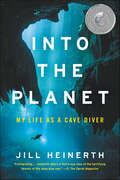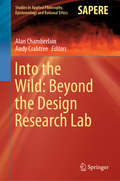- Table View
- List View
Interpreting Remote Sensing Imagery: Human Factors
by Arthur B. Markman Robert R. HoffmanNo matter how advanced the technology, there is always the human factor involved - the power behind the technology. Interpreting Remote Sensing Imagery: Human Factors draws together leading psychologists, remote sensing scientists, and government and industry scientists to consider the factors involved in expertise and perceptual skill.This boo
Interpretive Solutions for Dynamic Structures Through ABAQUS Finite Element Packages
by Farzad Hejazi Hojjat Mohammadi EsfahaniABAQUS software is a general-purpose finite element simulation package mainly used for numerically solving a wide variety of design engineering problems; however, its application to simulate the dynamic structures within the civil engineering domain is highly complicated. Therefore, this book aims to present specific complicated and puzzling challenges encountered in the application of Finite Element Method (FEM) for solving the problems related to Structural Dynamics using ABAQUS software that can fully utilize this method in complex simulation and analysis. Various chapters of this book demonstrate the process for the modeling and analysis of impenetrable problems through simplified step-by-step illustration by presenting screenshots from ABAQUS software in each part/step and showing various graphs. Highlights: Focuses on solving problems related to Structural Dynamics using ABAQUS software Helps to model and analyze the different types of structures under various dynamic and cyclic loads Discusses the simulation of irregularly-shaped objects comprising several different materials with multipart boundary conditions Includes the application of various load effects to develop structural models using ABAQUS software Covers a broad array of applications such as bridges, offshores, dams, and seismic resistant systems Overall, this book is aimed at graduate students, researchers, and professionals in structural engineering, solid mechanics, and civil engineering.
Interprofessional Simulation in Health Care: Materiality, Embodiment, Interaction (Professional and Practice-based Learning #26)
by Madeleine Abrandt Dahlgren Hans Rystedt Li Felländer-Tsai Sofia NyströmThis book describes and discusses a practice-oriented approach to understanding and researching interprofessional simulation-based education and simulation. It provides empirical findings from research on this topic and is informed by practice-oriented perspectives. It identifies critical features of the simulation practice and discusses how these can be used in reforming simulation pedagogy. The book is divided into three sections. Section 1 sets the scene for understanding the practices of interprofessional simulation-based education and simulation. It provides a theoretical and methodological framework for the conceptualisation of practices and for the empirical studies on which the book is based. Section 2 revisits the dimensions of the simulation process/exercise, i.e. the briefing, simulation, and debriefing, and provides empirical analyses of how the practice of simulation unfolds. Based on these analyses, section 3 identifies and discusses how pedagogies for simulation can be reformed to meet the demands of future healthcare and research.
Interrelationship Between Insects and Plants
by Pierre JolivetOne of the world's most insightful writers on the subject brings together an array of important and readable information on the ways in which insects and plants coexist in nature. Interrelationship Between Insects and Plants is a rare and expansive look at the intertwining of these two vastly different species. Its aim is to summarize in a simple a
Interrogating Development: The Mobilisation of Science, Technologies, and Technical Assistance in Postwar Mexico
by Gisela Mateos Edna Suárez-DíazThis volume explores the diverse meanings and ways of implementing development programs and technical assistance projects, through several case studies grounded in Mexico but transcending its geography. Despite – or perhaps because of – claims of &“revolutionary nationalism&”, Mexico played a crucial international role during the decades following World War II, both by challenging and enacting developmentalist models, values, and projects that stressed national priorities, resonating beyond its borders and even outside Latin America. Energy, irrigation, communication infrastructures, nuclear technologies, public health, and patents, are meaningful examples explored in this volume of the mobilisation of science and technologies understood in a broad sense, including not only the natural and social sciences, but also bureaucratic technologies that accompanied infrastructural and industrial projects. These case studies interrogate the specific agents and mechanisms of technical assistance put to work to meet local priorities, which in turn required and informed different international models and ideas of development.
Intersection of Artificial Intelligence, Data Science, and Cutting-Edge Technologies: ICAISE’2024, Volume 1 (Lecture Notes in Networks and Systems #1353)
by Tutut Herawan Yousef Farhaoui Agbotiname Lucky Imoize Ahmad El AllaouiThis book explores the integration of AI, data science, and emerging technologies to create innovative, practical solutions for smart environments. This book offers a comprehensive framework that combines theoretical concepts with real-world applications, focusing on how these technologies intersect to transform various domains such as healthcare, urban planning, and sustainable development. The book's novel approach emphasizes interdisciplinary methods and problem-solving in dynamic, data-driven environments, with case studies illustrating practical impacts and advancements in smart city infrastructure, IoT, and predictive analytics. It is designed for researchers, practitioners, and advanced students interested in AI and data science applications within smart systems, as well as professionals seeking actionable insights to apply these technologies in complex environments.
Intersection of Artificial Intelligence, Data Science, and Cutting-Edge Technologies: ICAISE’2024, Volume 2 (Lecture Notes in Networks and Systems #1397)
by Tutut Herawan Yousef Farhaoui Agbotiname Lucky Imoize Ahmad El AllaouiOffering a comprehensive exploration, this book navigates through foundational concepts to advanced applications, providing readers with a holistic understanding of how these domains intersect to create intelligent and responsive environments. The Intersection of Artificial Intelligence, Data Science, and Cutting-Edge Technologies: From Concepts to Applications in Smart Environments delves into the convergence of AI, data science, and innovative technologies within the realm of smart environments. Through a blend of theoretical insights and practical examples, the book illuminates the synergies between AI and data science, showcasing their pivotal roles in shaping the future of smart environments. From sensor technologies to machine learning algorithms, the text elucidates the mechanisms driving intelligence in these environments, while also delving into the ethical considerations and societal impacts of deploying such technologies. Whether you're a researcher, practitioner, or enthusiast in the fields of AI, data science, or smart environments, this book serves as a guiding beacon, offering valuable insights and methodologies to navigate the complexities of creating and optimizing intelligent environments for the benefit of society.
Intersections in Simulation and Gaming: 21st Annual Simulation Technology And Training Conference, Simtect 2016, And 47th International Simulation And Gaming Association Conference, Isaga 2016, Held As Part Of The First Australasian Simulation Congress, Asc 2016, Melbourne, Vic, Australia, September 26-29, 2016, Revised Selected Papers (Lecture Notes in Computer Science #10711)
by Anjum Naweed Marcin Wardaszko Elyssebeth Leigh Sebastiaan MeijerThis book constitutes the refereed post-conference proceedings of the 21st Annual Simulation Technology and Training Conference, SimTecT 2016, and the 47th International Simulation and Gaming Association Conference, ISAGA 2016, Held as Part of the First Australasian Simulation Congress, ASC 2016, held in Melbourne, VIC, Australia, in September 2016. The 28 revised full papers included in the volume were carefully reviewed and selected from 55 submissions. They are organized in the following topical sections: Making the grade; Come to think of it; From here to fidelity; The name of the game; and Ahead of the game.
Intersections in Simulation and Gaming: Third Australasian Simulation Congress, ASC 2019, Gold Coast, Australia, September 2–5, 2019, Proceedings (Communications in Computer and Information Science #1067)
by Anjum Naweed Lorelle Bowditch Cyle SprickThis book constitutes the refereed proceedings of the Australasian Simulation Congress, ASC 2019, held in Gold Coast, Australia in September 2019. The 10 papers presented were carefully reviewed and selected from 17 submissions. They provide a forum for sharing progresses in the areas of human dimensions; gaming experience; design and application; search and rescue; defence-oriented technology and training.
Intersections of Formal and Informal Science (Routledge Research in Education #165)
by Wolff-Michael Roth Lucy AvraamidouScience learning that takes place between and at the intersections of formal and informal science environments has not been systematically reviewed to offer a comprehensive understanding of the existing knowledge base. Bringing together theory and research, this volume describes the various ways in which learning science in various settings has been conceptualized as well as empirical evidence to illustrate how science learning in these settings can be supported.
Interstellar: The Search for Extraterrestrial Life and Our Future in the Stars
by Avi Loeb“The world's leading alien hunter” — New York Times MagazineFrom acclaimed Harvard astrophysicist and bestselling author of Extraterrestrial comes a mind-expanding new book explaining why becoming an interstellar species is imperative for humanity’s survival and detailing a game plan for how we can settle among the stars.In the New York Times bestseller Extraterrestrial, Avi Loeb, the longest serving Chair of Harvard’s Astronomy Department, presented a theory that shook the scientific community: our solar system, Loeb claimed, had likely been visited by a piece of advanced alien technology from a distant star. This provocative and persuasive argument opened millions of minds internationally to the vast possibilities of our universe and the existence of intelligent life beyond Earth. But a crucial question remained: now that we are aware of the existence of extraterrestrial life, what do we do next? How do we prepare ourselves for interaction with interstellar extraterrestrial civilization? How can our species become interstellar?Now Loeb tackles these questions in a revelatory, powerful call to arms that reimagines the idea of contact with extraterrestrial civilizations. Dismantling our science-fiction fueled visions of a human and alien life encounter, Interstellar provides a realistic and practical blueprint for how such an interaction might actually occur, resetting our cultural understanding and expectation of what it means to identify an extraterrestrial object. From awe-inspiring searches for extraterrestrial technology, to the heated debate of the existence of Unidentified Aerial Phenomena, Loeb provides a thrilling, front-row view of the monumental progress in science and technology currently preparing us for contact. He also lays out the profound implications of becoming—or not becoming—interstellar; in an urgent, eloquent appeal for more proactive engagement with the world beyond ours, he powerfully contends why we must seek out other life forms, and in the process, choose who and what we are within the universe.Combining cutting edge science, physics, and philosophy, Interstellar revolutionizes the approach to our search for extraterrestrial life and our preparation for its discovery. In this eye-opening, necessary look at our future, Avi Loeb artfully and expertly raises some of the most important questions facing us as humans, and proves, once again, that scientific curiosity is the key to our survival.
Interval Analysis: Application in the Optimal Control Problems (IEEE Press Series on Control Systems Theory and Applications)
by Navid RazmjooyInterval Analysis An innovative and unique application of interval analysis to optimal control problems In Interval Analysis: Application in the Optimal Control Problems, celebrated researcher and engineer Dr. Navid Razmjooy delivers an expert discussion of the uncertainties in the analysis of optimal control problems. In the book, Dr. Razmjooy uses an open-ended approach to solving optimal control problems with indefinite intervals. Utilizing an extended, Runge-Kutta method, the author demonstrates how to accelerate its speed with the piecewise function. You’ll find recursive methods used to achieve more compact answers, as well as how to solve optimal control problems using the interval Chebyshev’s function. The book also contains: A thorough introduction to common errors and mistakes, generating uncertainties in physical models Comprehensive explorations of the literature on the subject, including Hukurara’s derivatives Practical discussions of the interval analysis and its variants, including the classical (Minkowski) methods Complete treatments of existing control methods, including classic, conventional advanced, and robust control. Perfect for master’s and PhD students working on system uncertainties, Interval Analysis: Application in the Optimal Control Problems will also benefit researchers working in laboratories, universities, and research centers.
Interval Methods for Solving Nonlinear Constraint Satisfaction, Optimization and Similar Problems: From Inequalities Systems to Game Solutions (Studies in Computational Intelligence #805)
by Bartłomiej Jacek KubicaThis book highlights recent research on interval methods for solving nonlinear constraint satisfaction, optimization and similar problems. Further, it presents a comprehensive survey of applications in various branches of robotics, artificial intelligence systems, economics, control theory, dynamical systems theory, and others. Three appendices, on the notation, representation of numbers used as intervals’ endpoints, and sample implementations of the interval data type in several programming languages, round out the coverage.
Interval Methods for Uncertain Power System Analysis (IEEE Press Series on Power and Energy Systems)
by Alfredo VaccaroInterval Methods for Uncertain Power System Analysis In Interval Methods for Uncertain Power System Analysis, accomplished engineer Dr. Alfredo Vaccaro delivers a comprehensive discussion of the mathematical foundations of range analysis and its application to solving traditional power system operation problems in the presence of strong and correlated uncertainties. The book explores highly relevant topics in the area, from interval methods for uncertainty representation and management to a variety of application examples. The author offers readers the latest methodological breakthroughs and roadmaps to implementing the mathematics discussed within, as well as best practices commonly employed across the industry. Interval Methods for Uncertain Power System Analysis includes examinations of linear and non-linear equations, as well as: A thorough introduction to reliable computing, including discussions of interval arithmetic and interval-based operators Comprehensive explorations of uncertain power flow analysis, including discussions of problem formulation and sources of uncertainty in power flow analysis In-depth examinations of uncertain optimal power flow analysis Fulsome discussions of uncertain small signal stability analysis, including treatments of how to compute eigenvalues of uncertain matrices Perfect for engineers working in power flow and optimal power flow analyses, optimization theory, and computer aided simulation, Interval Methods for Uncertain Power System Analysis will also earn a place in the libraries of researchers and graduate students studying decision making under uncertainty in power systems operation.
Interval Reachability Analysis: Bounding Trajectories of Uncertain Systems with Boxes for Control and Verification (SpringerBriefs in Electrical and Computer Engineering)
by Murat Arcak Pierre-Jean Meyer Alex DevonportThis brief presents a suite of computationally efficient methods for bounding trajectories of dynamical systems with multi-dimensional intervals, or ‘boxes’. It explains the importance of bounding trajectories for evaluating the robustness of systems in the face of parametric uncertainty, and for verification or control synthesis problems with respect to safety and reachability properties. The methods presented make use of: interval analysis; monotonicity theory; contraction theory; and data-driven techniques that sample trajectories. The methods are implemented in an accompanying open-source Toolbox for Interval Reachability Analysis. This brief provides a tutorial description of each method, focusing on the requirements and trade-offs relevant to the user, requiring only basic background on dynamical systems. The second part of the brief describes applications of interval reachability analysis. This makes the brief of interest to a wide range of academic researchers, graduate students, and practising engineers in the field of control and verification.
Interval Type-3 Fuzzy Systems: Theory and Design (Studies in Fuzziness and Soft Computing #418)
by Oscar Castillo Patricia Melin Juan R. CastroThis book briefly reviews the basic concepts of type-2 fuzzy systems and then describes the proposed definitions for interval type-3 fuzzy sets and relations, also interval type-3 inference and systems. The use of type-2 fuzzy systems has become widespread in the leading economy sectors, especially in industrial and application areas, such as services, health, defense, and so on. However, recently the use of interval type-3 fuzzy systems has been receiving increasing attention and some successful applications have been developed in the last year. These issues were taken into consideration for this book, as we did realize that there was a need to offer the main theoretical concepts of type-3 fuzzy logic, as well as methods to design, develop and implement the type-3 fuzzy systems. A review of basic concepts and their use in the design and implementation of interval type-3 fuzzy systems, which are relatively new models of uncertainty and imprecision, are presented. The main focus of this work is based on the basic reasons of the need for interval type-3 fuzzy systems in different areas of application. In addition, we describe methods for designing interval type-3 fuzzy systems and illustrate this with some examples and simulations.
Interventions, Controls, and Applications in Occupational Ergonomics (The Occupational Ergonomics Handbook, Second Edition)
by Paul C. H. LiCompletely revised and updated, taking the scientific rigor to a whole new level, the second edition of the Occupational Ergonomics Handbook is now available in two volumes. This new organization demonstrates the enormous amount of advances that have occurred in the field since the publication of the first edition. The editors have brought together
Intestinal Failure and Rehabilitation: A Clinical Guide
by Laura E. Matarese Ezra Steiger Douglas L. SeidnerThe introduction of parenteral nutrition support has given patients with short bowel syndrome the time they need to achieve maximal intestinal rehabilitation and has allowed these patients to survive. The pioneering work of Drs. Byrnes and Wilmore in the 1990s focused on novel techniques to enhance intestinal adaptation and absorption, including mo
Into a Deeper Understanding of Evolutionary Computing: Volume 1 (Emergence, Complexity and Computation #50)
by Swagatam Das Abdul Hanif Abdul Halim Idris IsmailThis book delves into fundamental and advanced strategies for enhancing evolutionary and metaheuristic algorithms, focusing on the crucial balance between exploration and exploitation in search mechanisms. As technological advancements increase optimization complexity, effectively managing this balance becomes essential for achieving optimal solutions within reasonable computational resources. The book's distinctive structure organizes content according to optimization stages and processes, offering a comprehensive discussion of various approaches supported by extensive literature. The authors note a scarcity of literature addressing the trade-offs between exploration and exploitation with contemporary references, making this work particularly valuable. It aims to deepen the reader's understanding of evolutionary computing, emphasizing exploration, exploitation, and parameter control. It is relevant not only to algorithm developers and the evolutionary computation community but also to students and researchers across scientific disciplines. The book is designed to be accessible to those without extensive algorithm development backgrounds, providing theoretical and practical insights into optimization methods.
Into a Deeper Understanding of Evolutionary Computing: Volume 2 (Emergence, Complexity and Computation #51)
by Swagatam Das Abdul Hanif Abdul Halim Idris IsmailThis book delves into fundamental and advanced strategies for enhancing evolutionary and metaheuristic algorithms, focusing on the crucial balance between exploration and exploitation in search mechanisms. As technological advancements increase optimization complexity, effectively managing this balance becomes essential for achieving optimal solutions within reasonable computational resources. The book's distinctive structure organizes content according to optimization stages and processes, offering a comprehensive discussion of various approaches supported by extensive literature. The authors note a scarcity of literature addressing the trade-offs between exploration and exploitation with contemporary references, making this work particularly valuable. It aims to deepen the reader's understanding of evolutionary computing, emphasizing exploration, exploitation, and parameter control. It is relevant not only to algorithm developers and the evolutionary computation community but also to students and researchers across scientific disciplines. The book is designed to be accessible to those without extensive algorithm development backgrounds, providing theoretical and practical insights into optimization methods.
Into the Black: The Extraordinary Untold Story of the First Flight of the Space Shuttle Columbia and the Astronauts Who Flew Her
by Rowland WhiteA book &“no aviation buff will want to miss&” (The Wall Street Journal) and &“the perfect tale that educates as it entertains&” (Clive Cussler, #1 bestselling author), Into the Black recaptures the historic moments leading up to and the exciting story of the astronauts who flew the daring maiden flight of the space shuttle Columbia.Using interviews, NASA oral histories, and recently declassified material, Into the Black pieces together the dramatic untold story of the Columbia mission and the brave people who dedicated themselves to help the United States succeed in the age of space exploration. On April 12, 1981, NASA’s Space Shuttle Columbia blasted off from Cape Canaveral. It was the most advanced, state-of-the-art flying machine ever built, challenging the minds and imagination of America’s top engineers and pilots. Columbia was the world’s first real spaceship: a winged rocket plane, the size of an airliner, and capable of flying to space and back before preparing to fly again. On board were moonwalker John Young and test pilot Bob Crippen. Less than an hour after Young and Crippen’s spectacular departure from the Cape, all was not well. Tiles designed to protect the ship from the blowtorch burn of re-entry were missing from the heat shield. If the damage to Columbia was too great, the astronauts wouldn’t be able to return safely to earth. NASA turned to the National Reconnaissance Office, a spy agency hidden deep inside the Pentagon whose very existence was classified. To help the ship, the NRO would attempt something never done before. Success would require skill, perfect timing, and luck. Set against the backdrop of the Cold War, Into the Black is a thrilling race against time and the incredible true story of the first space shuttle mission that celebrates our passion for spaceflight.
Into the Deep: Science, Technology, and the Quest to Protect the Ocean
by Christy PetersonContaining 97 percent of Earth's water supply, the ocean plays a huge role in regulating global temperatures, supporting plant and animal life, and contributing to the livelihoods of millions of people. But in spite of all this, the ocean remains drastically unexplored, and the details of its impact on human lives aren't fully understood. Scientists from around the world are realizing that to address issues plaguing the ocean, such as dead zones, coral bleaching, and climate change, we need to better understand this incredible, unique feature of our planet. With a range of impressive, cutting-edge technologies at their disposal, oceanographers have set out to measure, sample, and analyze at every turn. Every day, mysteries about the ocean are being solved, and every day, new questions come to light. The more scientists learn, the better they are able to answer these new questions. What lies in the deep? And who is at the forefront of these exciting discoveries? The scientists and research included in this book shed light on the most pressing issues currently facing oceanographers and point us in the right direction to solving these challenges.
Into the Great Emptiness: Peril And Survival On The Greenland Ice Cap
by David RobertsA Library Journal Best Book of 2022 in Science and Technology “A gripping saga—and one of Roberts’s finest books.” —Jon Krakauer The riveting story of one of the greatest but least-known sagas in the history of exploration. By 1930, no place in the world was less well explored than Greenland. The native Inuit had occupied the relatively accessible west coast for centuries. The east coast, however, was another story. In August 1930, Henry George Watkins (nicknamed “Gino”), a twenty-three-year-old British explorer, led thirteen scientists and explorers on an ambitious expedition to the east coast of Greenland and into its vast and forbidding interior to set up a permanent meteorological base on the icecap, 8,200 feet above sea level. The Ice Cap Station was to be the anchor of a transpolar route of air travel from Europe to North America. The weather on the ice cap was appalling. Fierce storms. Temperatures plunging lower than –50° Fahrenheit in the winter. Watkins’s scheme called for rotating teams of two men each to monitor the station for two months at a time. No one had ever tried to winter over in that hostile landscape, let alone manage a weather station through twelve continuous months. Watkins was younger than anyone under his command. But he had several daring trips to the Arctic under his belt and no one doubted his judgement. The first crisis came in the fall when a snowstorm stranded a resupply mission halfway to the top for many weeks. When they arrived at the ice cap, there were not enough provisions and fuel for another two-man shift, so the station would have to be abandoned. Then team member August Courtauld made an astonishing offer. To enable the mission to go forward, he would monitor the station solo through the winter. When a team went up in March to relieve Courtauld, after weeks of brutal effort to make the 130-mile journey, they could find no trace of him or the station. By the end of March, Courtauld’s situation was desperate. He was buried under an immovable load of frozen snow and was disastrously short on supplies. On April 21, four months after Courtauld began his solitary vigil, Gino Watkins set out inland with two companions to find and rescue him. David Roberts, “veteran mountain climber and chronicler of adventures” (Washington Post), draws on firsthand accounts and archival materials to tell the story of this daring expedition and of the epic survival ordeal that ensued.
Into the Planet: My Life as a Cave Diver
by Jill HeinerthThe renowned cave diver takes readers on “a thrill ride into unfamiliar worlds”—exploring the hidden depths of our oceans and sunken caves (Publishers Weekly).More people have died exploring underwater caves than climbing Mount Everest, and we know more about deep space than we do about the depths of our oceans. In this thrilling firsthand account, Jill Heinerth blends science, adventure, and memoir to bring readers face-to-face with the terror and beauty of earth’s final frontier—and the extremes of human capability.One of the world’s foremost cave divers, Heinerth’s achievements include leading a team that discovered the ancient watery remains of Mayan civilizations and becoming the first person in history to dive deep into an Antarctic iceberg. In Into the Planet, she vividly recounts everything from discovering new species and examining our finite freshwater reserves to the prejudices women face when pursuing careers underwater.
Into the Wild: Beyond the Design Research Lab (Studies in Applied Philosophy, Epistemology and Rational Ethics #48)
by Andy Crabtree Alan ChamberlainThis edited collection opens up new intellectual territories and articulates the ways in which academics are theorising and practicing new forms of research in ‘wild’ contexts. Many researchers are choosing to leave the familiarity of their laboratory-based settings in order to pursue in-situ studies ‘in the wild’ that can help them to better understand the implications of their work in real-world settings. This has naturally led to ethical, philosophical and practical reappraisals with regard to the taken for granted lab-based modus operandi of scientific, cultural and design-based ways of working. This evolving movement has led to a series of critical debates opening up around the nature of research in the wild, but up until now these debates have not been drawn together in a coherent way that could be useful in an academic context. The book brings together applied, methodological and theoretical perspectives relating to this subject area, and provides a platform and a source of reference material for researchers, students and academics to base their work on. Cutting across multiple disciplines relating to philosophy, sociology, ethnography, design, human–computer interaction, science, history and critical theory, this timely collection appeals to a broad range of academics in varying fields of research.
